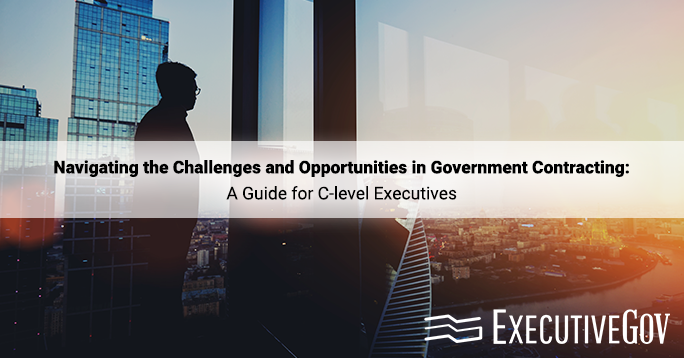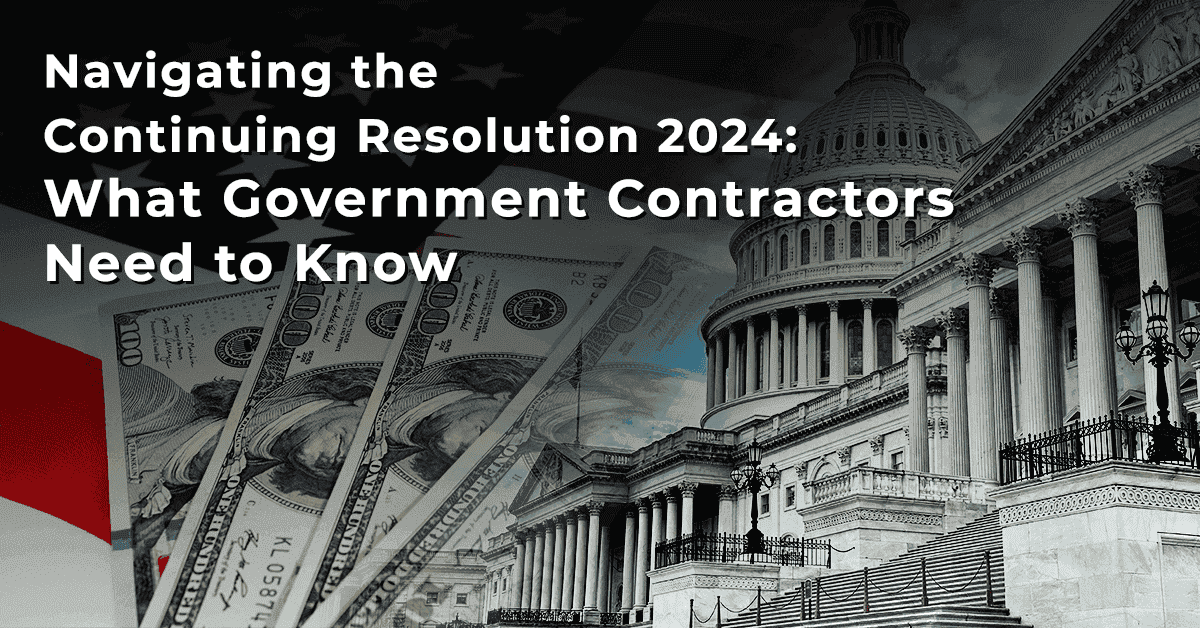C-level executives in all sectors face unique challenges and opportunities in government contracting. These may range from compliance with federal regulations and uncontrollable economic challenges to building strategic relationships toward success.
This article explores C-level executives’ challenges, provides actionable strategies to succeed, and highlights the importance of leadership skills in this highly competitive and regulated environment.
Table of Contents
5 Challenges that Chief Executives Face in Government Contracting

Government contracting is an environment with strict oversight, making it challenging for chief executives across all business scales. Here are some of the challenges mentioned by chief executives in the past:
Staying compliant
The Federal Acquisition Regulation (FAR) is the primary set of rules in government procurement. Compliance with the FAR is the key to avoiding consequences like contract loss and legal action.
Government contractors must also comply with regulations like the Anti-Kickback Act and the Foreign Corrupt Practices Act, which aim to prevent fraud and ensure fair competition.
In the healthcare sector, chief compliance officers (CCOs) must maintain integrity and ethical standards, laws, regulations, and evolving standards. The Department of Health and Human Services’s Office of Inspector General supports CCOs by providing voluntary guidance documents to monitor compliance with laws and program requirements.
Regarding the Cybersecurity Maturity Model Certification (CMMC), according to GovConWire, survey results showed that 24% of respondents expect to earn CMMC Level 1 status, while 27% expect to achieve CMMC Level 2. Meanwhile, 27% of executives are unsure about the CMMC level their firm will attain.
Implementing these regulations can be challenging for businesses.
Cost of innovation
Companies that work for the government need to innovate and meet industry needs. These cost contractors in their research and development (R&D), prototype development, testing, and experimentation efforts.
For instance, Pfizer invested millions in building a new facility to further advance its gene therapy capabilities. Lockheed Martin opened a new facility in its Waterton Campus in Denver, Colorado, to increase the production of small satellites yearly.
The government provides incentives through tax deductions under Section 174 of the IRS Code to offset these costs, but government contractors still have to pay for the cost of innovation.
Latest trends in technology
Federal agencies actively incorporate advanced technologies like AI, 5G networks, cloud computing, quantum technology, and cybersecurity into their operations. As a result, contractors must be able to offer modern IT services and solutions like AI, ML, and blockchain.
Chief Information Officers (CIOs) must ensure that their companies stay up-to-date with new policies and best practices that align with the government’s approach to emerging technologies. This includes understanding and adapting to policy updates such as the Federal Information Technology Acquisition Reform Act (FITARA).
Additionally, there are system upgrades and generative AI to improve service provision and security that executives need to learn and offer.
Identifying new revenue sources
Depending heavily on government contracting can be risky if the government cuts its funding. Therefore, it’s always a good idea to have multiple sources of revenue to mitigate these risks.
For example, 73% of Lockheed Martin’s revenue in 2022 came from contracts and subcontracts from the U.S. government. The F-35 program made up 27% of its total consolidated net sales. It would financially hurt the company’s operations if the government decided to reduce spending on that program or cancel its orders.
However, only 26% of its sales came from international and 1% from commercial customers. They operate in four market segments to diversify their business. Tapping into different markets and offering a wide range of products and companies can protect themselves from the potential impact of changes in government contracting.
Increasing competition
Healthcare, construction, medical, defense, and technology are the most dominant sectors in government contracting. Established contractors with a proven track record may have an advantage over new contract bidders, which can discourage competition.
For example, Amazon Web Services has been a major cloud provider for government intelligence agencies such as the CIA since 2013. Even though a competitor protested, Amazon was re-awarded the $10 billion contract from the NSA in April 2022.
Another challenge is that even if a contractor does everything right in preparing and submitting a competitive bid or proposal, another contractor may file a protest. This could be because they believe the bidding process was flawed or they chose the winning contractor uncarefully.
Protests can be filed against federal agencies’ procurement actions. The Government Accountability Office (GAO) handles these protests under the Competition in Contracting Act of 1984 (CICA). The good thing is that bid protests filed with the GAO are usually resolved more quickly than those filed in federal court.
Opportunities for C-level Executives

Despite the imminent and innumerable challenges that C-level executives face in government contracting, there are several opportunities they can take advantage of:
Attend summits and virtual events
Government contracting is constantly evolving with strict regulations. Attending these events can help leaders understand and adapt to any changes.
The Potomac Officers Club hosts a series of events valuable for top company executives:
- The 10th Annual Defense R&D Summit gathers defense leaders, researchers, experts, and decision-makers to discuss advanced technology for the U.S. military.
- The 5th Annual CIO Summit provides CIOs and private sector leaders a platform to explore modernization strategies and collaborate on innovative solutions.
- The 2024 Healthcare Summit focuses on critical issues such as artificial intelligence, telehealth, regulatory changes, data analytics, healthcare workforce shortage, health equity, and healthcare delivery models.
Leverage personal relationships
Building professional relationships is the best way to find new opportunities for success. Executives can leverage relationships to gain a competitive edge, create long-term business opportunities, and understand the needs and priorities of government buyers.
Getting to know important decision-makers like contract officers and program managers is important in government contracting. They can do this by asking for meetings to discuss how your products and services meet their agency’s goals, showing why your offer is valuable, and proving your commitment to providing great solutions.
For top executives transitioning into the private sector, some programs teach skills needed to partner with the government successfully. These programs help federal contractors build strong relationships with the government.
Use competitive and market intelligence tools
Competitive and market intelligence tools help organizations gather, store, and understand information about their competitors, markets, and customers. This includes data from external and internal sources, such as social media, websites, product information, and financial reports.
These tools offer a central place for all relevant information so stakeholders can use it for their needs.
ArchIntel is a global information network that provides leaders in business and nonprofits with clear and actionable intelligence to gain a strong competitive advantage. It provides daily briefings for executives carefully curated to give the most relevant information.
Understand the government’s strategic sourcing
Strategic sourcing involves reducing suppliers, improving communication, and building long-term relationships to maximize value. The U.S. government aims to save money while improving efficiency, leading agencies to make smarter purchases, cut unnecessary expenses, and use their buying power to save taxpayer dollars.
Understanding government procurement processes and initiatives like strategic outsourcing can help executives align their business strategies with government needs.
Executives should study the General Services Administration’s (GSA) role in federal purchasing, including sales to smaller entities like state and local agencies. They can also explore the Federal Procurement Data System used by the government to track spending on purchases over $3,000 to optimize their approach to government contracting.
Strategies for Success in Government Contracting

Here are several strategies executives can employ to succeed in government procurement:
Buy large quantities of supplies
Purchasing larger quantities or in bulk can reduce the price from the supplier. An even better strategy is for companies to establish their production facilities.
Embrace new technologies
There have been many advancements, especially in cloud computing and DevSecOps, which were impossible a few years ago. Nowadays, DevSecOps methods and technology have become increasingly present.
Companies are shifting from a step-by-step approach to software development toward a more constant delivery of updates. This helps organizations be more flexible, modernize their IT and systems faster, adopt new technologies, and enhance client and customer experiences.
Forecasting
Boswell noted that forecasting is important in the success and improvement of GovCon companies. Moreover, the GAUGE Report says that a company’s pipeline forecast affects cash flow, indirect rates, and labor forecast.
Mistakes in the pipeline forecast can lead to errors in other predictions. The report points out immature forecasting policies and reliance on spreadsheets for these inaccuracies.
Many government contractors still store opportunity data in siloed spreadsheets, limiting team visibility and collaboration. This results in potentially flawed pipeline forecasts based on outdated or incomplete information.
Using purpose-built technology is a great solution for improvement and gaining a competitive edge. For instance, an opportunity pipeline tool can greatly enhance forecast accuracy to gain insights into revenue and resource needs. This helps companies manage their pipeline effectively and adjust forecasts as opportunities progress.
Effective contract management
Effective contract management is important because it streamlines business operations, compliance with regulations, and successful relationships with partners. Here are some strategies to manage contracts effectively:
- Do a background check of the other party before legally finalizing the contractual agreement
- Define contract lifecycle, including negotiation, execution, performance monitoring, and renewal or termination
- Agree on review processes to ensure the contract is executed according to agreed terms and identify potential issues
- Use contract management software to automate processes
- Communicate regularly and establish reporting mechanisms





